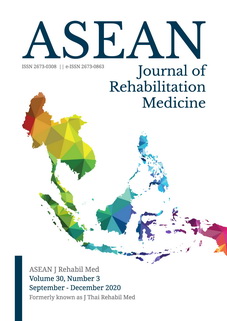Effectiveness of Prefabricated Silicone Toe Separator on Hallux Valgus
Keywords:
hallux, hallux valgus, pain, orthotic device, footAbstract
Objectives: To determine effectiveness of a prefabricated silicone toe separator to decrease hallux valgus angle (HVA) |and hallux pain, and also investigate possible complications, compliance, and users’ satisfaction.
Study design: Prospective cohort analytical study design
Setting: Foot Clinic, Department of Rehabilitation Medicine, Faculty of Medicine Siriraj Hospital
Subjects: Forty patients with hallux valgus deformity at moderate level (HVA 20°- 40°) were recruited from February to March 2019.
Methods: The participants were asked to wear a prescribed prefabricated silicone toe separator in proper shoes 6 hours a day for 12 months, and continue their current medication and treatment regimen. They had to record the duration of wearing the toe separator and complications in a logbook on a weekly basis. Follow-up pain numeric rating scale (pain NRS) and HVA measured from radiography were evaluated at 6 months, and 12 months after receiving the device.
Results: Thirty-eight participants returned for follow-up at a 6-month and 33 participants continued until the end of the study. Based on per protocol and intention to treat analyses, the results showed no progression of HVA. Pain at the 1st metatarsophalangeal joint decreased with a statistically significant difference (p < 0.001) at 12 months. Nearly 60% of participants had minor complications. The common complication was discomfort at the 1st web space.
Conclusion: Wearing a prefabricated silicone toe separator in proper shoes for a year in patients with a moderate degree of hallux valgus could prevent the progression of hallux valgus angle and decrease hallux pain without serious complications.
Keywords: hallux, hallux valgus, pain, orthotic device, foot
References
Mann RA, Coughlin MJ. Adult hallux valgus. In: Mann RA, Coughlin MJ, editors. Surgery of the foot and ankle. 7th ed. St Louis: Mosby-Yearbook; 1999. p. 150-269.
Turan I. Correlation between hallux valgus angle and age. J Foot Surg. 1990;29:327-9.
Pique-Vidal C, Sol´e MT, Antich J. Hallux valgus inheritance: pedigree research in 350 patients with bunion deformity. J Foot Ankle Surg. 2007;46:149-54.
Frey C, Thompson F, Smith J, Sanders M, Horstman H. American Orthopaedic Foot and Ankle Society women’s shoe survey. Foot Ankle. 1993;14:78-81.
Perera A, Mason L, Stephens M. The pathogenesis of hallux valgus. J Bone Joint Surg Am. 2011;93:1650-61.
D’Arcangelo PR, Landorf KB, Shannon E, Gerard V, Hylton B. Radiographic correlates of hallux valgus severity in older people. J Foot Ankle Res. 2010;3:20. doi:10.1186/1757-1146-3-20.
Di Giovanni CW, Kuo R, Tejwani N, Price R, Hansen ST Jr, Cziernecki J, et al. Isolated gastrocnemius tightness. J Bone Joint Surg Am. 2000;84:962-70.
Carl A, Ross S, Evanski P, Waugh T. Hypermobility in hallux valgus. Foot Ankle. 1988;8:264-70.
Roukis TS, Landsman AS. Hypermobility of the first ray: a critical review of the literature. J Foot Ankle Surg. 2003;42:377-90.
Coughlin MJ. Juvenile hallux valgus: etiology and treatment. Foot Ankle Int. 1995;16:682-97.
Crawford AH, Gabriel KR. Foot and ankle problems. Orthop Clin North Am. 1987;18:649-66.
Sim-Fook L, Hodgson AR. A comparison of foot forms among the non-shoe and shoe-wearing Chinese population. J Bone Joint Surg Am. 1958;40:1058-62.
Coughlin MJ. Hallux valgus. Am Acad Orthop Surg. 1997;46:932-66.
Coughlin MJ. Hallux valgus. Causes, evaluation, and treatment. Postgrad Med. 1984;75:174-87.
Kato T, Watanabe S. The etiology of hallux valgus in Japan. Clin Orthop. 1981;157:78-81.
Sánchez-Gómez R. Heel height as an etiology of hallux abductus valgus development: an electromagnetic static and dynamic first metatarsophalangeal joint study. Sensors. 2019;19:1328. doi:10.3390/s19061328.
Coughlin MJ, Jones CP. Hallux valgus: demographics, etiology, and radiographic assessment. Foot Ankle Int. 2007;28:759-77.
Easley ME, Trnka HJ. Current concepts review: hallux valgus part 1: pathomechanics, clinical assessment, and nonoperative management. Foot Ankle Int. 2007;28:654-9.
Tang SF, Chen CP, Pan J-L, Chen J-L, Leong C-P, Chu N-K. The effects of new foot-toe orthosis in treating painful hallux valgus. Arch Phys Med Rehabil. 2002;83:1792-5.
Tehraninasr A, Saeedi H, Forogh B, Bahramizadeh M, Keyhani M. Effects of insole with toe-separator and night splint on patients with painful hallux valgus: a comparative study. Prosthet Orthot Int. 2008;32:79-83.
Ray J, Friedmann J, Hanselman E, Vaida J, Dayton P, Hatch DJ, et al. Hallux valgus. Foot & Ankle Orthopaedics. 2019;4:1-12. doi: 10.1177/2473011419838500
Hurn SE, Vicenzino BT, Smith MD. Non-surgical treatment of hallux valgus: a current practice survey of Australian podiatrists. J Foot Ankle Res. 2016;9:16. doi:10.1186/s13047-016-0146-5.
Groiso JA. Juvenile hallux valgus: a conservative approach to treatment. J Bone Joint Surg Am. 1992;74:1367-74.
Chadchavalpanichaya N, Prakotmongkol V, Polhan N, Rayothee P, Seng-Iad S. Effectiveness of the custom mold room temperature vulcanizing silicone toe separator on hallux valgus: a prospective, randomized single-blinded controlled trial. Prosthet Orthot Int. 2018;42:163-70.






